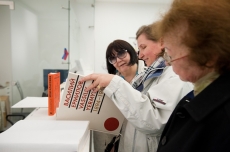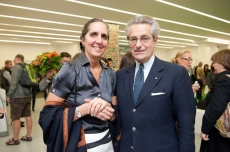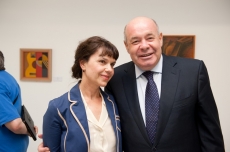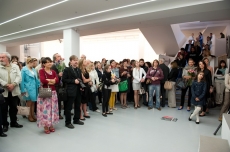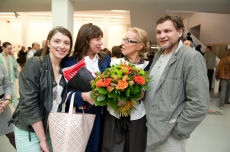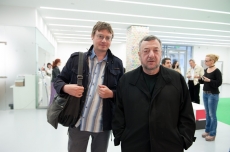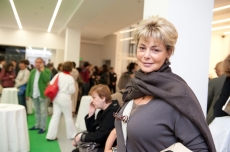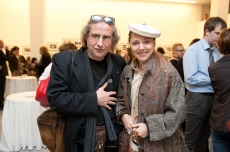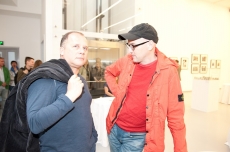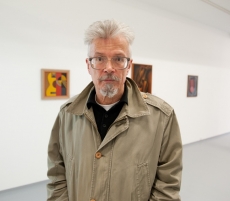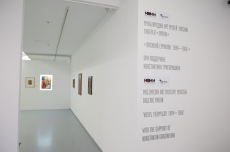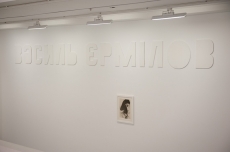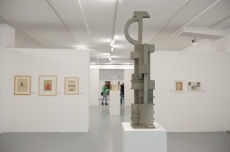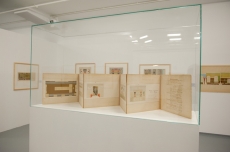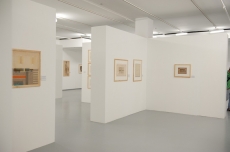Vasyl Yermylov. 1894-1968
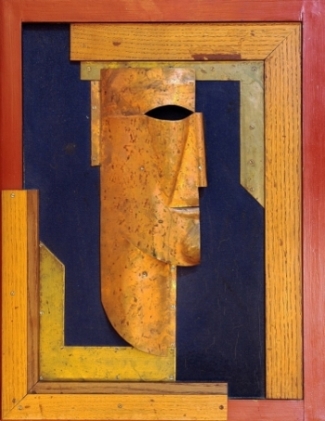
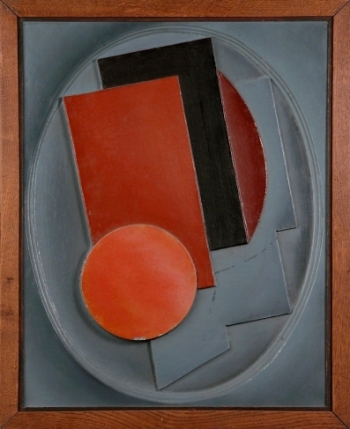
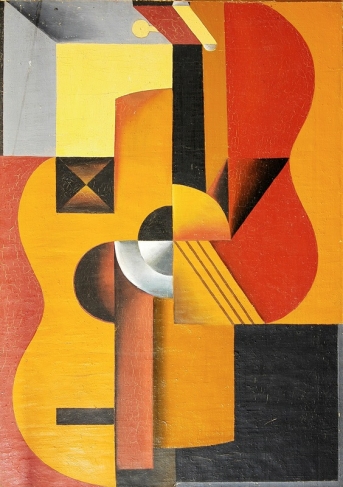
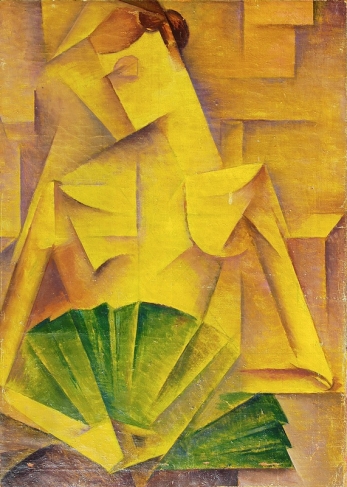
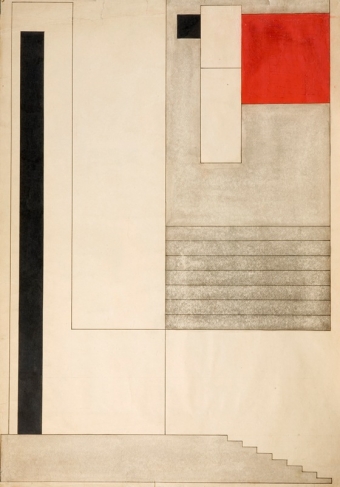

Vasyl Yermylov. Portrait of the Artist Alexei Pochtenny. 1924. Tinted wood, metal, copper, oil, powder (sand). Collection of Konstantin Grigorishin, Moscow
Vasyl Yermylov. Relief. 1923. Oil on wood. Collection of Andrey Eremin, Moscow
Vasyl Yermylov. Guitar. 1919. Oil on canvas. Collection of Konstantin Grigorishin, Moscow
Vasyl Yermylov. Lady with a Fan. 1919. Oil on canvas. Collection of Konstantin Grigorishin, Moscow
Vasyl Yermylov. Project of monument to ‘President of the Globe’ V. Khlebnikov. Sketch. 1965. Gouache and pencil on paper. Collection of Konstantin Grigorishin, Moscow
Vasyl Yermylov. Palace of Pioneers and Little Octobrists in Kharkov. Interior design project. 1934–1935. Gouache and pencil on paper mounted on cardboard. Collection of Konstantin Grigorishin, Moscow
Vasyl Yermylov. Palace of Pioneers and Little Octobrists in Kharkov. Interior design project. 1934–1935. Gouache on paper. Collection of Konstantin Grigorishin, Moscow
Unknown author. Vasyl Yermylov. Agitprop advertising tribune-stand for the 10th Anniversary of the October Revolution Exhibition. Kharkov. 1927. Silver print. Collection of Konstantin Grigorishin, Moscow
Vasyl Yermylov. Sculpture composition ‘Three Russian Revolutions: 1825, 1905 and 1917’. Sketch. 1922–1925. Gouache on paper mounted on cardboard. Sepherot Foundation, Liechtenstein
Vasyl Yermylov. Sculpture composition ‘Three Russian Revolutions: 1825, 1905 and 1917’. 1924–1925. Painted wood, lacquer. Sepherot Foundation, Liechtenstein
Vasyl Yermylov. ‘Lenin and October. 1917–1924’. Sketch for book cover. 1920s. Gouache and pencil on paper. Collection of Konstantin Grigorishin, Moscow
Vasyl Yermylov. Three book finishings. 1922. Indian ink on paper. Collection of Konstantin Grigorishin, Moscow
Moscow, 5.06.2012—22.07.2012
exhibition is over
Vasyl Dmytrovich Yermylov
For the press
In Kharkiv Yermylov became a member of the Budiak and Vykus groups of artists, wearing a bow-tie and a beret wide ’as the Black Sea’. He produced the magazine Avangard and taught at the Kharkov Art Institute from the 1920s to 1930s. In 1928 Yermylov participated in the International Press Exhibition in Cologne, and in 1937 designed the Ukrainian SSR pavilion for the All-Union Agricultural Exhibition in Moscow. Western art critics commented that ’Yermylov needs two sticks for a finished composition, while Lissitzky needs a minimum of three’.
In 1949 Yermylov was expelled from the Artists’ Union for cosmopolitanism and only reinstated ten years later. Vasyl Yermylov had just one solo exhibition during his lifetime (1962). The artist’s studio was destroyed by fire and his works dispersed, ending up in the private and museum collections of various countries.
His skills as an interior and fresco painter, taste for traditional culture, revolutionary thinking, and also a remarkable plasticity and sense of texture and colour make Yermylov one of the leading industrial designers and pioneers in ’industrial aesthetics’ of his period. The universality of the applied artist together with classical training and new spatial conceptualisation resulted in an oeuvre that includes reliefs and counter-reliefs; collages and assemblages; typefaces and logotypes; theatre costumes and sets; monuments; stands; murals for laboratories, Communist Party study centres and agitprop trains; propaganda leaflets and advertising hoardings; photographic panels and book covers; packaging designs and cigarette box maquettes... Yermylov was able to synthesise Bauhaus Constructivism, the zeal of the Futurists, Khlebnikov’s ’narodnik’ tendency and Suprematist minimalism in his graphics, painting and three-dimensional works, developing his own unique style that combined vitality, simplicity and plasticity.
I was born in 1894, in Kharkov. My father was a peasant, a tailor by profession from Rakitnaya, a village in the Kursk region, Graivoron district. My mother also came from a peasant family in the Kursk region, Belgorod district. After leaving the 12th Municipal Parish School in 1905 I began my studies at the Kharkov Art and Craft Studio of Painting the same year, graduating in 1909 — diploma No. 33 of 20 May 1909. After three years of practical experience as a decorative painter I was given the title ‘master of decorative painting’ — certificate No. 22 of 6 May 1914. In 1910 I began a course at the Municipal School of Drawing and Painting, and in 1911 studied in the workshop of artists Shteinberg, Zagonov and Grot. I attended classes at the Moscow Painting, Sculpture and Architecture College in 1912. Later I studied painting in the studio of Mashkov and Konchalovsky, drawing in the artist Meshkov’s workshop and etching with the artist Gaman. In 1913 several of my etchings were displayed in an exhibition by Moscow artists. In 1913 I worked independently, earning my living by decorative painting and graphics. In 1915 I was drafted for military service and in 1918 demobilised. I served as a private, suffering wounds and shell-shock. I was awarded the Cross of St. George 4th Class. From December 1918 to 1919 I helped organise the Provincial Department of People’s Education Arts Committee.
From January 1920 I worked as master in the art department of UkROSTA and master-director of the industrial art combine. In 1921 I was a Vseizdat artist. From 1922 I was head of Kharkov Art College graphic studio, and professor of the Kharkov Art Institute until 1964. From 1934 to 1935 I worked on construction of the Kharkov Palace of Pioneers as artist-designer, and in 1936 on construction of the Kiev House of Defence as artist-architect for the 2nd Architectural-Art Workshop. In 1937 I designed the interior of the Ukrainian SSR pavilion for the All-Union Agricultural Exhibition in Moscow. In 1939 I was pictorial and poster production artist for the Mistetstvo State Publishing House. In 1940 I designed the State Theatre Museum and worked for the Mistetstvo publishers. In 1941 I was invited to work at the Kiev Art Institute.
On 13 July I was summoned for military service and assisted in the defence of Kiev and Chernigov as division artist. In September 1941 we were surrounded and only escaped from encirclement in December 1941. I was wounded. Until 1943 I was in occupied territory. In February 1943 (Kharkov was occupied by the Red Army) I headed the agitprop art workshop. From 23 August 1943 I was in charge of the USSR Art Foundation art studio and deputy director of the Kharkov Art Institute. In 1944 and 1945 I taught technology and art technology at the Kharkov Art Institute and worked as an artist in the art-production workshops of the SSKh Art Foundation and as workshop art director for the municipal chief architect’s department.
I was an artist in the medical institute experimental workshops from 1946 to 1947, and artist-designer of the Kharkov Association of Artists until January 1957. Since February 1957 I have been a pensioner. I have been a member of the trade union Rabis since 1920 and of the Union of Soviet Artists since 1939. In 1931 Rukh Publishers published a monograph of my work.
I was the organiser of several art exhibitions: Art Production in 1922, the First All-Ukrainian Association of Revolutionary Art of the Ukraine in 1926, ‘10 Years Since October’ in 1927, Ukrainian Book Graphics in 1929.
From 1913 to 1962 I have taken part in a number of exhibitions. Among those held abroad, at the Leipzig exhibition in 1922 I received a gold medal for graphic works. I participated in the 1929 ‘Pressa’ exhibition in Cologne.
Voluntary Public Work
1. Chairman of the Factory-Combine Committee
2. Chairman of the ITR Bureau
3. Member of the Tariff-Valuation Commission
4. Organiser of the Kharkov Association of Artists
5. Participant in lectures and debates
6. Head of the Fine Arts Studio for Working Youth
7. Lecturer on raising the qualifications of Art Foundation artists
8. Artistic editor of the magazine Avangard 13
Major Art Production Projects
1. Wall-painting for the Red Army Club garrison, 1920 (UkROSTA)
2. Mural for the agit-train ‘Chervona Ukrasha’ (1921)
3. Book, magazine and poster design for the publishers DVU, Rukh and Mistetstvo
4. Wall newspapers ‘Generator’, ‘Kanatka’ and 20 albums for the ‘Pressa’ exhibition in Cologne, 1928
5. Advertising tribune for ‘10 Years Since October’ (1927)
6. Design of Dzerzhinsky Square
7. Design of Feuerbach and Rudnev Squares for the 30th anniversary of the October Revolution
8. Literary Gallery (Kharkov)
9. Theatre Museum (Kiev)
10. Pioneer Palace (Kharkov),
11. House of Defence (Kiev), 1936
12. Study of the Lenin Marxist-Leninist Club
13. Room of T. Shevchenko (KhATO and B)
14. ‘How to Work on a Book’ exhibition
15. Design for workshop No. 2 of the 8th State Bearings Factory
16. Design project for Dzerzhinsky Square on the 50th anniversary of the Great October Revolution
Conclusion
Since my creative activities were focused on the production of small-scale architectural features, mainly during the pre-war period, I have also devoted considerable time as artist-constructor to experimental projects, as well as graphic design and teaching. By increasing my knowledge in the sphere of painting and drawing, I try to use the great artistic heritage of all ages and peoples; as a result of analysing and learning about the principles of figurative thinking, I have become convinced that the cultural erudition of the Soviet artist is still underdeveloped and unable to produce the great art characteristic of many past epochs. In my view the reason for this lies in the decline of professional mastery, in our poor formulation of the educational process. The 20 years I spent teaching have shown me that this stagnation arose largely because the path to literacy in the fundamentals of our craft has been inadequately prepared. The teaching process leads to superficial dilettantism. Those who have grasped this amateurish system pass it on in turn to the next generation, creating a closed circle.
Young people, i.e. artists, are eager to show their face and go to extremes, thereby mistaking method (mannerism) for an original interpretation of form without any proper analysis. Gimmickry has become such a widespread phenomenon that many perceive it to be a manifestation of ‘genius’. You need only look and listen as young artists try to comprehend ‘how it’s done’ at exhibitions of their work, gazing at one another in amazement.
1960s

